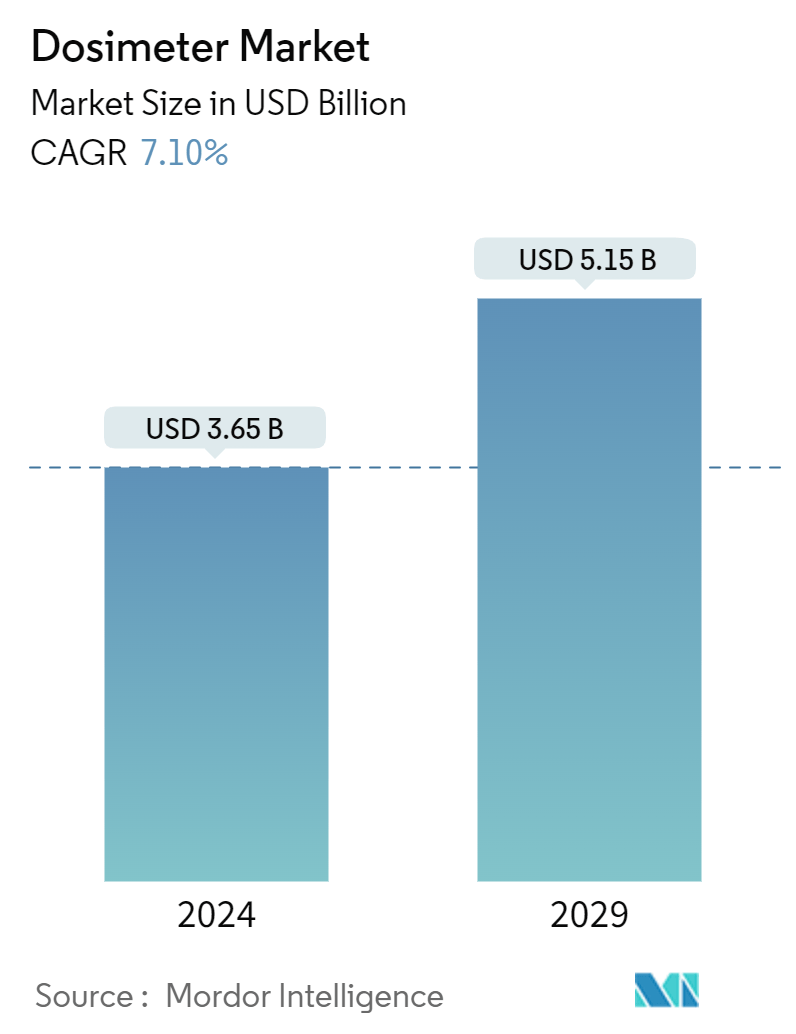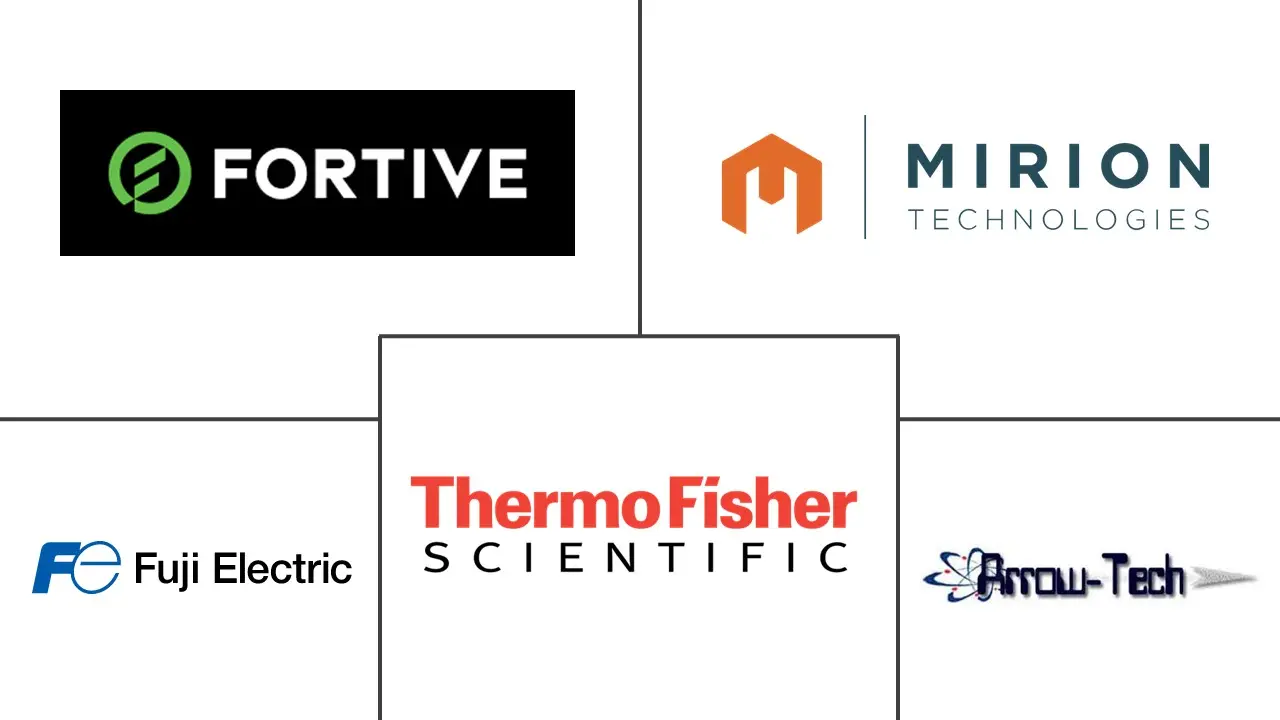Market Size of Dosimeter Industry

| Study Period | 2019 - 2029 |
| Market Size (2024) | USD 3.65 Billion |
| Market Size (2029) | USD 5.15 Billion |
| CAGR (2024 - 2029) | 7.10 % |
| Fastest Growing Market | Asia Pacific |
| Largest Market | North America |
Major Players
*Disclaimer: Major Players sorted in no particular order |
Dosimeter Market Analysis
The Dosimeter Market size is estimated at USD 3.65 billion in 2024, and is expected to reach USD 5.15 billion by 2029, growing at a CAGR of 7.10% during the forecast period (2024-2029).
- Dosimeters have diverse applications in various industries, including the medical and manufacturing sectors. In the manufacturing sector, using radioactive sources or X-ray machines has increased the need for dosimeters to monitor radiation exposure over an extended period. Passive dosimeters, such as film badges and thermoluminescent dosimeters, are commonly used for routine monitoring in the manufacturing industry.
- Government regulations, which aim to control emissions and ensure labor safety, boost the demand for dosimeters in the industrial sector. However, the device's high cost, sensitivity to electromagnetic fields, and mechanical instability can hinder the growth of the active dosimeter market.
- The demand for dosimeters is propelled by the increasing prevalence of cardiovascular diseases, cancer, and neurology-related conditions, necessitating precise radiation monitoring. Dosimetry equipment finds extensive applications in nuclear medicine and therapeutic radiopharmaceuticals, presenting lucrative prospects. Healthcare practitioners are embracing wearable dosimeters to analyze radiation levels, while the rising use of imaging devices mandates robust radiation exposure monitoring.
- Market growth is further fueled by continuous research and development efforts aimed at enhancing dosimeter technology. Advancements such as miniaturization enable real-time monitoring with smaller, wearable dosimeters, catering to diverse industries from nuclear facilities to space exploration.
- Additionally, dosimeters equipped with wireless communication capabilities facilitate seamless data transfer and remote monitoring, while personalized dosimetry approaches consider individual variations in radiation sensitivity, incorporating techniques like biodosimetry and accounting for genetic variability.
- Overall, the demand for dosimeters is expected to grow in various industries, driven by factors such as the increasing use of radiation-mediated technology, government regulations, and the need for worker safety. However, market growth may be limited by factors such as the high cost of the device and its sensitivity to environmental factors.
- In June 2024, Thermo Fisher Scientific announced the launch of the Thermo Scientific NetDose Pro digital dosimeter, a wearable, connected device for monitoring radiation. This compact instrument is designed to track and inform radiation exposure risk for personnel in a variety of industries, such as healthcare, and help companies adhere to stringent regulatory requirements.
Dosimeter Industry Segmentation
Dosimeters are calibration devices that track and gauge radiation exposure to high-energy X-rays, beta, and gamma rays. Electronic personal, thermoluminescent, optically stimulated luminescent, and film badge dosimeters are a few of the frequently used dosimeters. When the permitted limits are surpassed, they send a visual or audio alert while monitoring the radiation exposure. They are commonly worn by medical professionals and industrial employees who spend much time around radiation and dangerous chemicals.
The dosimeter market is segmented by type (electronic personal dosimeter (EPD), thermo luminescent dosimeter (TLD), optically stimulated luminescence dosimeters (OSLD), film badge dosimeter, and other types), application (active and passive), end-user industry (healthcare, oil and gas, mining, nuclear plants, industrial, manufacturing, and other end-user industries), and geography (North America, Europe, Asia-Pacific, Latin America, and the Middle East and Africa). The report offers market sizes and forecasts for all the above segments in value terms (USD).
| By Type | |
| Electronic Personal Dosimeter (EPD) | |
| Thermo Luminescent Dosimeter (TLD) | |
| Optically Stimulated Luminescence Dosimeters (OSL) | |
| Film Badge Dosimeter | |
| Other Types |
| By Application | |
| Active | |
| Passive |
| By End-user Industry | |
| Healthcare | |
| Oil and Gas | |
| Mining | |
| Nuclear Plants | |
| Industrial | |
| Manufacturing | |
| Other End-user Industries |
| By Geography*** | |
| North America | |
| Europe | |
| Asia | |
| Australia and New Zealand | |
| Latin America | |
| Middle East and Africa |
Dosimeter Market Size Summary
The dosimeter market is poised for significant growth, driven by its diverse applications across industries such as healthcare, manufacturing, and nuclear energy. In the manufacturing sector, the increasing use of radioactive sources and X-ray machines has heightened the demand for dosimeters to monitor radiation exposure, supported by stringent government regulations aimed at ensuring worker safety. The COVID-19 pandemic further amplified this demand, particularly in settings requiring UV disinfection, where dosimeters are essential for measuring UV exposure to protect workers. Despite the promising growth prospects, challenges such as high costs and sensitivity to environmental factors may impede the market's expansion.
The Asia-Pacific region is expected to lead the global dosimeter market, fueled by the rising adoption of nuclear power and stringent safety regulations in countries like China, Japan, and India. China's ambitious nuclear power expansion plans and Japan's aging population are key factors driving demand for dosimeters in these regions. Additionally, South Korea's advancements in radiation therapy contribute to market growth. The market is moderately fragmented, with major players like Fortive Corporation and Mirion Technologies Inc. enhancing their offerings through strategic partnerships and technological innovations. These developments, alongside ongoing research and development initiatives, are anticipated to bolster the dosimeter market's growth trajectory over the forecast period.
Dosimeter Market Size - Table of Contents
-
1. MARKET INSIGHTS
-
1.1 Market Overview
-
1.2 Industry Attractiveness - Porter's Five Forces Analysis
-
1.2.1 Bargaining Power of Suppliers
-
1.2.2 Bargaining Power of Buyers
-
1.2.3 Threat of New Entrants
-
1.2.4 Threat of Substitute Products
-
1.2.5 Intensity of Competitive Rivalry
-
-
1.3 Industry Value Chain Analysis
-
1.4 Impact of COVID-19 After-effects and Other Macroeconomic Factors on the Market
-
-
2. MARKET SEGMENTATION
-
2.1 By Type
-
2.1.1 Electronic Personal Dosimeter (EPD)
-
2.1.2 Thermo Luminescent Dosimeter (TLD)
-
2.1.3 Optically Stimulated Luminescence Dosimeters (OSL)
-
2.1.4 Film Badge Dosimeter
-
2.1.5 Other Types
-
-
2.2 By Application
-
2.2.1 Active
-
2.2.2 Passive
-
-
2.3 By End-user Industry
-
2.3.1 Healthcare
-
2.3.2 Oil and Gas
-
2.3.3 Mining
-
2.3.4 Nuclear Plants
-
2.3.5 Industrial
-
2.3.6 Manufacturing
-
2.3.7 Other End-user Industries
-
-
2.4 By Geography***
-
2.4.1 North America
-
2.4.2 Europe
-
2.4.3 Asia
-
2.4.4 Australia and New Zealand
-
2.4.5 Latin America
-
2.4.6 Middle East and Africa
-
-
Dosimeter Market Size FAQs
How big is the Dosimeter Market?
The Dosimeter Market size is expected to reach USD 3.65 billion in 2024 and grow at a CAGR of 7.10% to reach USD 5.15 billion by 2029.
What is the current Dosimeter Market size?
In 2024, the Dosimeter Market size is expected to reach USD 3.65 billion.

